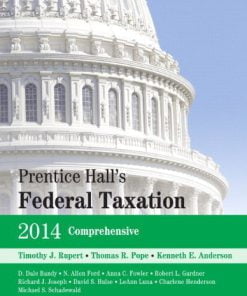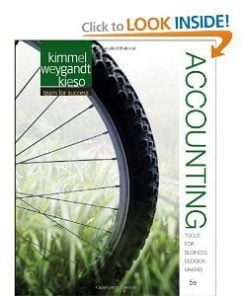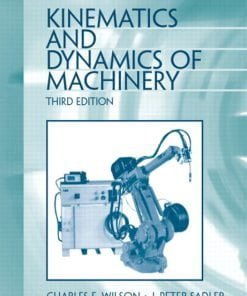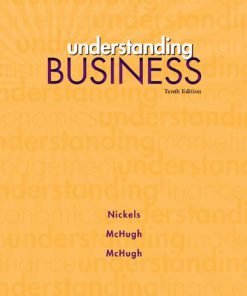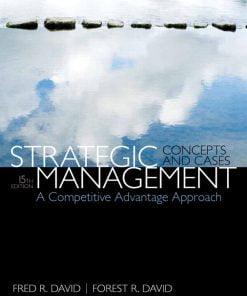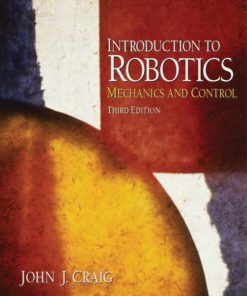Biosignal and Medical Image Processing 3rd Semmlow Solution Manual
$55.00 Original price was: $55.00.$29.99Current price is: $29.99.
Biosignal and Medical Image Processing 3rd Semmlow Solution Manual
Biosignal and Medical Image Processing 3rd Semmlow Solution Manual
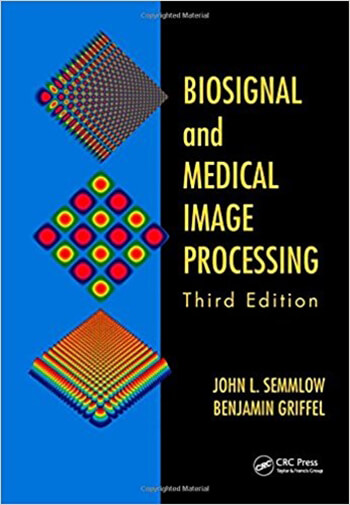
Product details:
- ISBN-10 : 1466567368
- ISBN-13 : 978-1466567368
- Author: Semmlow
Written specifically for biomedical engineers, Biosignal and Medical Image Processing, Third Edition provides a complete set of signal and image processing tools, including diagnostic decision-making tools, and classification methods. Thoroughly revised and updated, it supplies important new material on nonlinear methods for describing and classifying signals, including entropy-based methods and scaling methods. A full set of PowerPoint slides covering the material in each chapter and problem solutions is available to instructors for download.
Table contents:
- Chapter 1 Introduction
- 1.1 Biosignals
- 1.2 Biosignal Measurement Systems
- 1.3 Transducers
- 1.4 Amplifier/Detector
- 1.5 Analog Signal Processing and Filters
- 1.5.1 Filter Types
- 1.5.2 Filter Bandwidth
- 1.5.3 Filter Order
- 1.5.4 Filter Initial Sharpness
- 1.6 ADC Conversion
- 1.6.1 Amplitude Slicing
- 1.6.2 Time Slicing
- 1.6.3 Edge Effects
- 1.6.4 Buffering and Real-Time Data Processing
- 1.7 Data Banks
- 1.8 Summary
- Problems
- Chapter 2 Biosignal Measurements, Noise, and Analysis
- 2.1 Biosignals
- 2.1.1 Signal Encoding
- 2.1.2 Signal Linearity, Time Invariance, Causality
- 2.1.2.1 Superposition
- 2.1.3 Signal Basic Measurements
- 2.1.4 Decibels
- 2.1.5 Signal-to-Noise Ratio
- 2.2 Noise
- 2.2.1 Noise Sources
- 2.2.2 Noise Properties: Distribution Functions
- 2.2.3 Electronic Noise
- 2.3 Signal Analysis: Data Functions and Transforms
- 2.3.1 Comparing Waveforms
- 2.3.1.1 Vector Representation
- 2.3.1.2 Orthogonality
- 2.3.1.3 Basis Functions
- 2.3.2 Correlation-Based Analyses
- 2.3.2.1 Correlation and Covariance
- 2.3.2.2 Matrix of Correlations
- 2.3.2.3 Cross-Correlation
- 2.3.2.4 Autocorrelation
- 2.3.2.5 Autocovariance and Cross-Covariance
- 2.3.3 Convolution and the Impulse Response
- 2.4 Summary
- Problems
- Chapter 3 Spectral Analysis: Classical Methods
- 3.1 Introduction
- 3.2 Fourier Series Analysis
- 3.2.1 Periodic Functions
- 3.2.1.1 Symmetry
- 3.2.2 Complex Representation
- 3.2.3 Data Length and Spectral Resolution
- 3.2.3.1 Aperiodic Functions
- 3.2.4 Window Functions: Data Truncation
- 3.3 Power Spectrum
- 3.4 Spectral Averaging: Welch’s Method
- 3.5 Summary
- Problems
- Chapter 4 Noise Reduction and Digital Filters
- 4.1 Noise Reduction
- 4.2 Noise Reduction through Ensemble Averaging
- 4.3 Z-Transform
- 4.3.1 Digital Transfer Function
- 4.4 Finite Impulse Response Filters
- 4.4.1 FIR Filter Design and Implementation
- 4.4.2 Derivative Filters: Two-Point Central Difference Algorithm
- 4.4.2.1 Determining Cutoff Frequency and Skip Factor
- 4.4.3 FIR Filter Design Using MATLAB
- 4.5 Infinite Impulse Response Filters
- 4.5.1 IIR Filter Implementation
- 4.5.2 Designing IIR Filters with MATLAB
- 4.6 Summary
- Problems
- Chapter 5 Modern Spectral Analysis: The Search for Narrowband Signals
- 5.1 Parametric Methods
- 5.1.1 Model Type and Model Order
- 5.1.2 Autoregressive Model
- 5.1.3 Yule–Walker Equations for the AR Model
- 5.2 Nonparametric Analysis: Eigenanalysis Frequency Estimation
- 5.2.1 Eigenvalue Decomposition Methods
- 5.2.2 Determining Signal Subspace and Noise Subspace Dimensions
- 5.2.3 MATLAB Implementation
- 5.3 Summary
- Problems
- Chapter 6 Time–Frequency Analysis
- 6.1 Basic Approaches
- 6.2 The Short-Term Fourier Transform: The Spectrogram
- 6.2.1 MATLAB Implementation of the STFT
- 6.3 The Wigner–Ville Distribution: A Special Case of Cohen’s Class
- 6.3.1 The Instantaneous Autocorrelation Function
- 6.3.2 Time–Frequency Distributions
- 6.3.3 The Analytic Signal
- 6.4 Cohen’s Class Distributions
- 6.4.1 The Choi–Williams Distribution
- 6.5 Summary
- Problems
- Chapter 7 Wavelet Analysis
- 7.1 Introduction
- 7.2 Continuous Wavelet Transform
- 7.2.1 Wavelet Time–Frequency Characteristics
- 7.2.2 MATLAB Implementation
- 7.3 Discrete Wavelet Transform
- 7.3.1 Filter Banks
- 7.3.1.1 Relationship between Analytical Expressions and Filter Banks
- 7.3.2 MATLAB Implementation
- 7.3.2.1 Denoising
- 7.3.2.2 Discontinuity Detection
- 7.4 Feature Detection: Wavelet Packets
- 7.5 Summary
- Problems
- Chapter 8 Optimal and Adaptive Filters
- 8.1 Optimal Signal Processing: Wiener Filters
- 8.1.1 MATLAB Implementation
- 8.2 Adaptive Signal Processing
- 8.2.1 ALE and Adaptive Interference Suppression
- 8.2.2 Adaptive Noise Cancellation
- 8.2.3 MATLAB Implementation
- 8.3 Phase-Sensitive Detection
- 8.3.1 AM Modulation
- 8.3.2 Phase-Sensitive Detectors
- 8.3.3 MATLAB Implementation
- 8.4 Summary
- Problems
- Chapter 9 Multivariate Analyses: Principal Component Analysis and Independent Component Analysis
- 9.1 Introduction: Linear Transformations
- 9.2 Principal Component Analysis
- 9.2.1 Determination of Principal Components Using Singular-Value Decomposition
- 9.2.2 Order Selection: The Scree Plot
- 9.2.3 MATLAB Implementation
- 9.2.3.1 Data Rotation
- 9.2.4 PCA in MATLAB
- 9.3 Independent Component Analysis
- 9.3.1 MATLAB Implementation
- 9.4 Summary
- Problems
- Chapter 10 Chaos and Nonlinear Dynamics
- 10.1 Nonlinear Systems
- 10.1.1 Chaotic Systems
- 10.1.2 Types of Systems
- 10.1.3 Types of Noise
- 10.1.4 Chaotic Systems and Signals
- 10.2 Phase Space
- 10.2.1 Iterated Maps
- 10.2.2 The Hénon Map
- 10.2.3 Delay Space Embedding
- 10.2.4 The Lorenz Attractor
- 10.3 Estimating the Embedding Parameters
- 10.3.1 Estimation of the Embedding Dimension Using Nearest Neighbors
- 10.3.2 Embedding Dimension: SVD
- 10.4 Quantifying Trajectories in Phase Space: The Lyapunov Exponent
- 10.4.1 Goodness of Fit of a Linear Curve
- 10.4.2 Methods of Determining the Lyapunov Exponent
- 10.4.3 Estimating the Lyapunov Exponent Using Multiple Trajectories
- 10.5 Nonlinear Analysis: The Correlation Dimension
- 10.5.1 Fractal Objects
- 10.5.2 The Correlation Sum
- 10.6 Tests for Nonlinearity: Surrogate Data Analysis
- 10.7 Summary Exercises
- Chapter 11 Nonlinearity Detection: Information-Based Methods
- 11.1 Information and Regularity
- 11.1.1 Shannon’s Entropy Formulation
- 11.2 Mutual Information Function
- 11.2.1 Automutual Information Function
- 11.3 Spectral Entropy
- 11.4 Phase-Space-Based Entropy Methods
- 11.4.1 Approximate Entropy
- 11.4.2 Sample Entropy
- 11.4.3 Coarse Graining
- 11.5 Detrended Fluctuation Analysis
- 11.6 Summary
- Problems
- Chapter 12 Fundamentals of Image Processing: The MATLAB Image Processing Toolbox
- 12.1 Image-Processing Basics: MATLAB Image Formats
- 12.1.1 General Image Formats: Image Array Indexing
- 12.1.2 Image Classes: Intensity Coding Schemes
- 12.1.3 Data Formats
- 12.1.4 Data Conversions
- 12.2 Image Display
- 12.3 Image Storage and Retrieval
- 12.4 Basic Arithmetic Operations
- 12.5 Block-Processing Operations
- 12.5.1 Sliding Neighborhood Operations
- 12.5.2 Distinct Block Operations
- 12.6 Summary
- Problems
- Chapter 13 Image Processing: Filters, Transformations, and Registration
- 13.1 Two-Dimensional Fourier Transform
- 13.1.1 MATLAB Implementation
- 13.2 Linear Filtering
- 13.2.1 MATLAB Implementation
- 13.2.2 Filter Design
- 13.3 Spatial Transformations
- 13.3.1 Affine Transformations
- 13.3.1.1 General Affine Transformations
- 13.3.2 Projective Transformations
- 13.4 Image Registration
- 13.4.1 Unaided Image Registration
- 13.4.2 Interactive Image Registration
- 13.5 Summary
- Problems
- Chapter 14 Image Segmentation
- 14.1 Introduction
- 14.2 Pixel-Based Methods
- 14.2.1 Threshold Level Adjustment
- 14.2.2 MATLAB Implementation
- 14.3 Continuity-Based Methods
- 14.3.1 MATLAB Implementation
- 14.4 Multithresholding
- 14.5 Morphological Operations
- 14.5.1 MATLAB Implementation
- 14.6 Edge-Based Segmentation
- 14.6.1 Hough Transform
- 14.6.2 MATLAB Implementation
- 14.7 Summary
- Problems
- Chapter 15 Image Acquisition and Reconstruction
- 15.1 Imaging Modalities
- 15.2 CT, PET, and SPECT
- 15.2.1 Radon Transform
- 15.2.2 Filtered Back Projection
- 15.2.3 Fan Beam Geometry
- 15.2.4 MATLAB Implementation of the Forward and Inverse Radon Transforms: Parallel Beam Geometry
- 15.2.5 MATLAB Implementation of the Forward and Inverse Radon Transforms: Fan Beam Geometry
- 15.3 Magnetic Resonance Imaging
- 15.3.1 Magnetic Gradients
- 15.3.2 Data Acquisition: Pulse Sequences
- 15.4 Functional MRI
- 15.4.1 fMRI Implementation in MATLAB
- 15.4.2 Principal Component and ICA
- 15.5 Summary
- Problems
- Chapter 16 Classification I: Linear Discriminant Analysis and Support Vector Machines
- 16.1 Introduction
- 16.1.1 Classifier Design: Machine Capacity
- 16.2 Linear Discriminators
- 16.3 Evaluating Classifier Performance
- 16.4 Higher Dimensions: Kernel Machines
- 16.5 Support Vector Machines
- 16.5.1 MATLAB Implementation
- 16.6 Machine Capacity: Overfitting or “Less Is More”
- 16.7 Extending the Number of Variables and Classes
- 16.8 Cluster Analysis
- 16.8.1 K-Nearest Neighbor Classifier
- 16.8.2 k-Means Clustering Classifier
- 16.9 Summary
- Problems
- Chapter 17 Classification II: Adaptive Neural Nets
- 17.1 Introduction
- 17.1.1 Neuron Models
- 17.2 Training the McCullough–Pitts Neuron
- 17.3 The Gradient Decent Method or Delta Rule
- 17.4 Two-Layer Nets: Back Projection
- 17.5 Three-Layer Nets
- 17.6 Training Strategies
- 17.6.1 Stopping Criteria: Cross-Validation
- 17.6.2 Momentum
- 17.7 Multiple Classifications
- 17.8 Multiple Input Variables
- 17.9 Summary
- Problems
- Appendix A: Numerical Integration in MATLAB
- Appendix B: Useful MATLAB Functions
- Bibliography
- Index
People also search:
biosignal and medical image processing 3rd edition pdf
medical image processing companies
what is the most common form of medical imaging
biosignal and medical image processing pdf
|
image processing in biomedical engineering
|
Related products
Solution Manual
International Business Competing in the Global Marketplace Hill 10th Edition Solutions Manual
Solution Manual
Prentice Hall’s Federal Taxation 2014 Comprehensive Rupert 27th Edition Solutions Manual
Solution Manual
Solution manual for Accounting: Tools for Business Decision Making Kimmel Weygandt Kieso 5th Edition
Solution Manual
Solution Manual
Solution Manual
Understanding Business Nickels 10th Edition Solutions Manual
Solution Manual
Solution Manual
Solution Manual for Introduction to Robotics Mechanics and Control 3rd Edition by Craig





